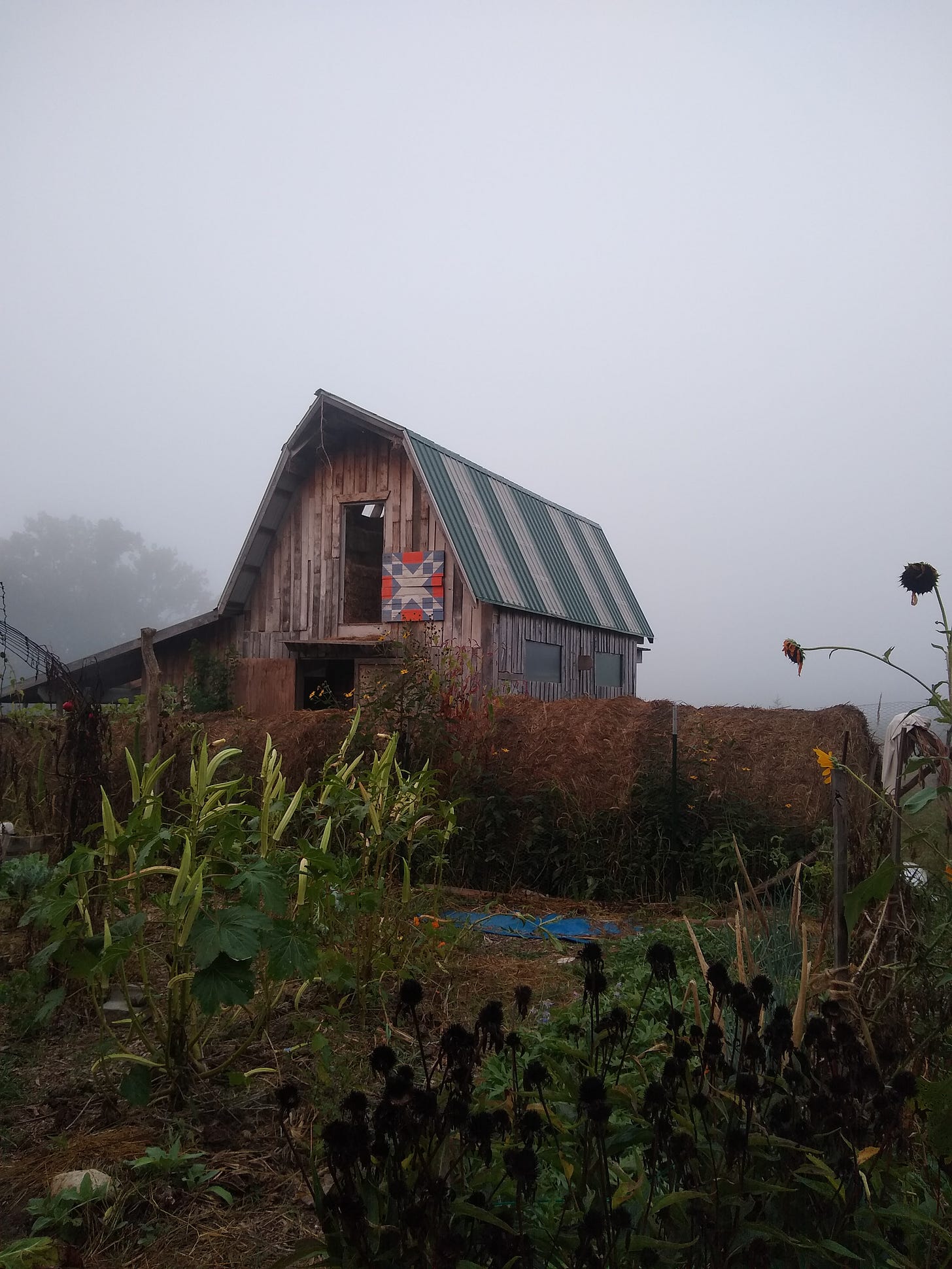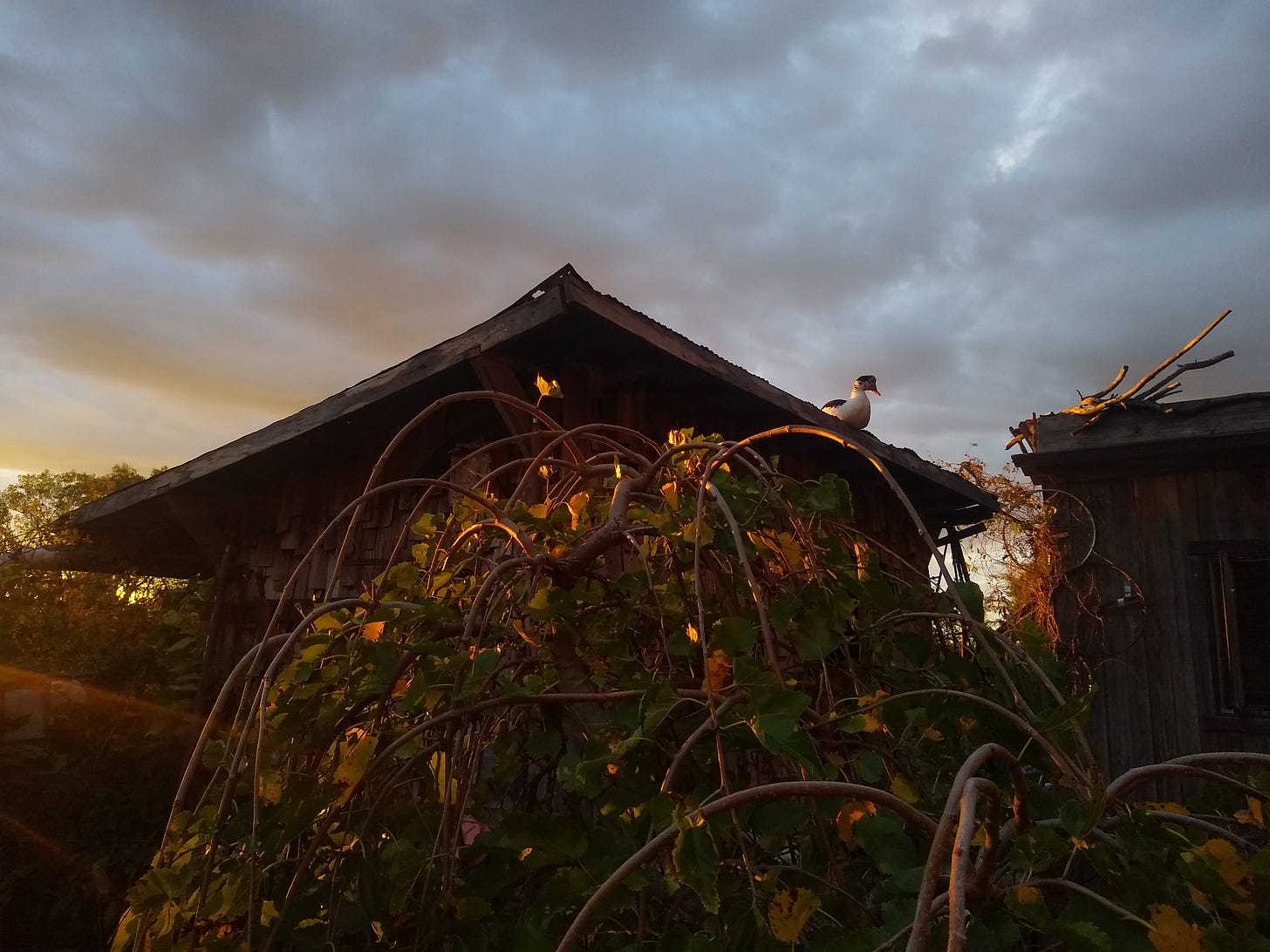Pumpkin Spice, Corn Demons, and the Springtime of Death
Setting aside the seasonal latte and embracing death for the Autumnal Equinox
The carcass of an old blown down honey locust awaits the saw where it has lain, propped against a neighboring pin oak which it has known for thirty or forty years, its crown partly pressed into the claypan of this slope; somewhere between the heaven it once caressed with its thorned stems and fine, compound leaves and the underworld of our stove in which it will burn this winter. The ground beneath it is strewn with masses and clumps of decayed leaves, cut short in their photosynthetic prime in the summer, and now gradually, a few other leaves join them there: elm, walnut, and cottonwood mostly. Not the crimson of oak or the high, bright yellow of silver maple, but the decidedly less showy shades of early dormancy that bring to mind the ugliness of dying, not the splendorous display that beacons mobs of pumpkin spice influencers out east and up north for photo ops. My apologies to any readers currently or soon-to-be inundated with fall colors tourists, but better there than here. Send ‘em through the gift shop on their way out.
The corn has nearly dried down for harvest, the barns and sheds are full of hay, and dead ripe tomatoes (that is they’re dead, and they’re not getting riper) punctuate withered vines. In lieu of crispy leaves that haven’t dropped here yet, we have clumps of duck down strewn hither and yon, plucked from the three dozen or so birds we’ve harvested thus far. The okra has slowed it’s growth, petrified husks of pods full of seeds projecting from tired plants, and the once verdant canopy of long beans in our hoop house has begun drying down to a ghostly mass of rattling ripe seedpods. Few of our summer crops are truly dead yet, but a lot of them are looking ready to be put out of their misery.
It ain’t pumpkin spice season this year, not around here. This is the springtime of death.
So, help me figure this out… is pumpkin spice a flavor that includes an essence of pumpkin (real or fake) or is it actually just nutmeg and cinnamon and allspice and copious amounts of sugar? I spent all day yesterday delivering produce and in the refueling process got suckered into buying a very large pumpkin spice cappuccino at the gas station. My bowels have not recovered as of this morning. Perhaps consuming pumpkin spice cappuccinos in Northeast Missouri is ill-advised, but I also imagine that the digestive effects of said drink would be the same regardless of regionality. We don’t really do pumpkin spice season round these parts: in Northeast Missouri it’s camo can season. Don’t be coy, you know what I mean. Because a beer that won’t scare the deer away is the perfect accessory for getting cryptically drunk in the woods with your buddies while operating firearms. If there’s one thing that makes me shit more than gas station (Casey’s) pumpkin spice cappuccino, it would have to be five to eight Mossy Oak edition Busch Originals gulped down while squatting in the brush, intermingled with beef jerky.
While most of the rest of America prepares to consume pumpkin in latte form, we’re looking forward to the aftermath, when we can stalk about in search of rotten jack-o-lanterns and decayed fall displays for a payload of hog-fattening fodder. We find the seeds of pumpkin and squash to be excellent dewormers prior to butcher season, and there is great joy to behold in watching a fat herd of swine demolish a truckload of squash. But we’re not quite there yet, and in fact it’s looking to get back up to the lower 90’s this weekend. But for now, the subtle hollowness and quiet of a fog-shrouded day gives some respite.
If early Autumn is like death’s springtime, then that first skein of southbound geese I heard this week is something like the crocus that pushes through snow, only a harbinger of colder days and darker nights ahead, and an urging to come sit at death’s buffet. It’s time to stock the larder, find my socks, and get back to being husky enough to keep my long pants up. The lighter fare of the summer garden, juicy tomatoes, crisp beans, and sugary peppers will give way to the fat of ducks and the fulfilling heft of squash and turnip. Despite my lack of access to professional dentistry, I crack a few wild hazelnuts in my teeth and take in a deep, cool breath. Unfortunately, it smells like someone’s burning trash nearby, but hey, that’s one of the parts they don’t tell you about rural living. Deer are emerging from their shelter, setting the dogs off on echoing waves of barks. Cardinals, and even a nuthatch have begun flitting onto the standing dead stalks of sunflower, and soon the Asian pear trees will be plucked entirely of their fruit. Save maybe for one.
In Germany, they have what is called feldgeister. Some vestige of pre-Christian agrarian folklore no doubt, they are quite literally field ghosts, or corn demons, who inhabit farm fields and find themselves chased down to the edge of the woods during harvest, sometimes quite literally nipped at by the slashing scythes of mowers bringing in the grain. It isn’t good to come across a feldgeister, as they can induce illness or worse, but they can be dissuaded from harming people by leaving a few heads of grain in the field, or fruits upon the orchard limbs. Some traditions hold that they are vanquished for the season once all the grain has been threshed, or when a corn doll has been ceremonially brought out of the field. And there are a lot of feldgeister to be worried about.
The roggenwold (rye wolf) steals and eats children. There’s also a corn wolf, barley wolf, pea wolf, grass wolf, plum wolf, potato wolf, and so on and so forth. Not to mention the kornhund (corn dog), heupuddel (hay poodle), and the kiddelhund (the “titillation dog” that tickles children to death). No joke. Then you’ve got your cats, donkeys, pigs, half-human half-cats, cows, three-legged goats, roosters that peck your eyes out, swans, toads, and even a few anti-Semitic feldgeister. And while I’m not sure of the need for that last example, it makes sense to have a few small rituals in place to motivate folks to leave a bit for the wildlife… a few years back I allowed our hogs and turkeys to take more acorns from the draw than was supportive of our squirrel population, which resulted in the squirrels sneaking out of the woods and into our tree plantings where they debarked several trees late in the winter for sustenance. I have not run the livestock that hard on pannage since, and resultingly have not seen squirrels behave this way since. You have got to keep your corn demons in their place, or otherwise get really good at eating them.
While agrarian folklore across the world seems to serve as good advice to country people, mostly through fear tactics, American agrarian folklore centers largely on predicting the weather. It never works for me, but a lot of folks swear by it. But again, I suppose a lot of folks swear by a variety of vague notions that haven’t been proven to work. Prime among them? Wooly bear and persimmon forecasting. It is said that if you slice a persimmon seed lengthwise, the shape revealed within will provide some foreshadowing of the winter ahead: A knife predicts a cold and icy winter that cuts through a person, a spoon means deep snow and plenty of shoveling, and a fork means it will be pleasant, for some reason. In my experience it is really hard to slice a persimmon seed lengthwise down the middle safely: the seed is small and slippery and without the world’s smallest vice it leaves the thumb and forefinger exposed to razor-sharp peril. Also, regardless of where you reside in the Midwest, winter will probably be some combination of these three conditions. And finally, they always look like a spoon.
Now the wooly bear is a measure whereby the ratio of black to orange adorning wooly bear caterpillars is said to correlate with the coldness and duration of winter, but to be honest, they’re all different. Why can’t we have field ghosts here that prey upon the young instead of making up easily disproved prophecies about caterpillars? Is this why we’re so bad at talking about climate in the U.S.?
Anyhow, the stench of immolated tractor tires has worn off out there, and the sun has begun to press through the shroud of fog lain over our little patch of sidehill here. Soon I will have to clean up some duck excreta left strewn about my yard and sterilize tools for our next day of butchering before another gasp of summer-like heat awakens the flies. Death lurks around the corner, but so does garlic planting, and there’s salsa to can, swine to herd, and wagons of turkeys to be moved about in pursuit of sluggish early morning locusts. I may be too hungry to leave fruit on the limb, but I have no qualms about feeding my scavenger friends a bucket or two of poultry entrails on the edges of our ghost-ridden draws. At least until I can find some Weston Price folks to buy ‘em, or they somehow become sanctified as Slow Food… with the list I’ve got and the current size of pants I need to fit I can’t afford to make up lies about farming forever. So here’s the truth: to raise food is as much about seeds, and nurture, and growth, and feel-good living, breathing, photosynthesizing lifestuff as it is about death, decay, and scavenging. In split stacks of wood and racks of jars and chopped down stalks and gutpiles we bury the last bits of our summertime dreams. Sometimes they become ghosts of our failure, hungry at the woodland edge, sometimes sweet memory revived by the prying of sealed lids. Whatever keeps you alive with your pants up ‘til spring planting is the thing to keep ahold of as we move inward for the season.
Probably turnips.
Not dead, just a bit gaunt,
BB






Really enjoyed this!